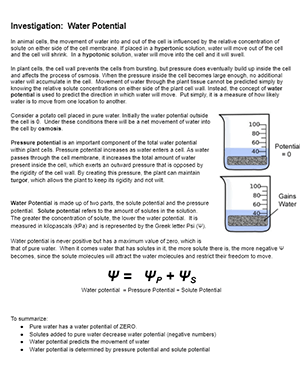
How can you determine the molarity of a carrot? If your chemistry is rusty, recall that molarity refers to the number of moles of solute in a liter of solution. From the carrot’s perspective, the solutes are a combination of sugars, proteins, and other macromolecules. Students use the concept of water potential to determine how water will move into or out of the cell.
The first page provides background information and definitions for water potential, solute potential, and pressure potential. Following this section, students answer multiple choice questions to check for understanding.
The second page outlines the procedure for putting baby carrots into beakers with different concentrations of sugar. You will need to provide students with beakers for measuring water, 6 baby carrots, and a scale to measure mass. You can reduce equipment needs by using plastic cups to submerge carrots.
After the carrots soak overnight, students weigh them again and record changes in mass. Students then graph the percent change on the graph so show where the change in mass would be equal to zero. That is the molarity of the carrot! Tip: You may need to model how to create a line of best fit on the graph. My students seem to always want to make bar graphs, which won’t be that helpful here.
From there, the molar concentration of the carrot is used to determine the solute potential of the sucrose solution. Students then complete a final synthesis which summarizes what they have learned.
Other Osmosis Labs
This lab was originally part of another investigation that used dialysis tubes to demonstrate osmosis: “Osmosis and Water Potential” This lab has been my go-to in past years for the cell membrane unit. Unfortunately, the set-up can take a long time and if your class periods are under an hour, students have difficulty setting it up and recording data. I separated this section to be a stand-along lab and give them more details about water potential.
You can also do a performance assessment where students determine the molarity of an unknown solution. In this activity, students use water beads and salt solutions.
Younger students might do experiments that don’t focus as much on water potential, but just look at the basics of osmosis, such as this lab that uses deco cubes soaked in salt water, tap water, and distilled water.
Finally, you can have students view actual cells from elodea that are soaked in salt water to observe how the cells lose water in response to a hypertonic solution.

